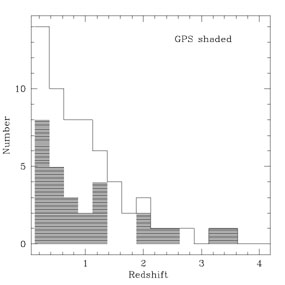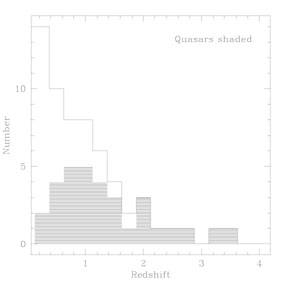


In contrast to the wealth of information on the radio properties of the GPS/CSS sources, until recently we have known very little about their optical properties. Recent work is beginning to give us some clues, but our picture is far from complete and much additional work remains to be done. Here I review our current understanding of the redshift distribution, host galaxy magnitudes, morphology, colors, polarization, and emission-line properties where known.
Fanti et al. (1990b) and
O'Dea et al. (1991)
presented the redshift distribution of the CSS and GPS sources,
respectively. Note that there are still six sources with unknown
redshifts in the complete sample. Figure 15 shows
the distribution of redshift for the combined sample, with GPS/CSS and
galaxies/quasars distinguished in the two plots. The main results are
these: (1) the GPS and CSS sources have similar redshift distributions;
(2) there are similar numbers of quasars and galaxies in the GPS/CSS
sources; (3) the quasars tend to be at higher redshifts than the
galaxies (i.e., all objects at z
 2 are quasars);
and (4) the z
2 are quasars);
and (4) the z
 2 quasars are
preferentially GPS rather than CSS. Recall that the GPS sources and the
PW
subset of the CSS sources are selected at centimeter wavelengths, where
the contributions from Doppler-boosted jets are most visible. Thus, the
results that there are similar numbers of quasars and galaxies and that
the quasars predominate at the higher redshifts are both consistent with
some Doppler boosting of the centimeter-wavelength radio emission in the
quasars.
2 quasars are
preferentially GPS rather than CSS. Recall that the GPS sources and the
PW
subset of the CSS sources are selected at centimeter wavelengths, where
the contributions from Doppler-boosted jets are most visible. Thus, the
results that there are similar numbers of quasars and galaxies and that
the quasars predominate at the higher redshifts are both consistent with
some Doppler boosting of the centimeter-wavelength radio emission in the
quasars.
 |
 |
Figure 15. (a) Histogram of redshifts for the Fanti et al. CSS sample and the Stanghellini et al. GPS sample (shaded). (b) Same as (a), but with the quasars shaded. |
The tendency for quasars at high redshifts to be GPS sources was noted by Peterson et al. (1982), Menon (1983, 1984), Savage & Peterson (1983), and Savage et al. (1990) and was explored in more detail by O'Dea (1990). This tendency seems to be real. The exact fractional contribution of GPS quasars to the radio-loud quasar population at high redshifts is uncertain but currently appears to be around ~ 30%. Thus, red, stellar GPS sources are strong candidates for high-redshift quasars and should be exploited as such.
The result that the GPS and CSS galaxies are found primarily at low to
intermediate redshifts 0.1
 z
z
 1 has
interesting implications for source evolution. It is in this redshift
range that the powerful radio sources begin to be found at the centers
of clusters, rather than in the sparser environments they frequent at
low redshift (see, e.g.,
Hill & Lilly 1991),
and it is here that the peculiar "alignment" effect between the optical
continuum light, the optical line-emitting gas, and the extended radio
source begins to emerge (see, e.g.,
McCarthy et al. 1987;
Chambers et al. 1987;
Miley & Chambers
1989).
Thus, the appearance of GPS/CSS sources at these redshifts, and their
apparent absence at lower redshifts, may indicate that these are indeed
young or frustrated sources whose birth is tied to the dynamical
processes of evolution occurring in clusters and groups of galaxies
(e.g., collapse of compact groups - see, e.g.,
Mamon 1987).
In particular, the higher frequency of mergers at these redshifts (see,
e.g., Roos 1985;
Zepf & Koo 1989;
Carlberg 1990)
may play an important role in their formation.
1 has
interesting implications for source evolution. It is in this redshift
range that the powerful radio sources begin to be found at the centers
of clusters, rather than in the sparser environments they frequent at
low redshift (see, e.g.,
Hill & Lilly 1991),
and it is here that the peculiar "alignment" effect between the optical
continuum light, the optical line-emitting gas, and the extended radio
source begins to emerge (see, e.g.,
McCarthy et al. 1987;
Chambers et al. 1987;
Miley & Chambers
1989).
Thus, the appearance of GPS/CSS sources at these redshifts, and their
apparent absence at lower redshifts, may indicate that these are indeed
young or frustrated sources whose birth is tied to the dynamical
processes of evolution occurring in clusters and groups of galaxies
(e.g., collapse of compact groups - see, e.g.,
Mamon 1987).
In particular, the higher frequency of mergers at these redshifts (see,
e.g., Roos 1985;
Zepf & Koo 1989;
Carlberg 1990)
may play an important role in their formation.
One remaining question is, where are the low-redshift (z < 0.1) counterparts of the GPS and CSS sources? Are they hiding as LINERs (e.g., 1718-649; Tingay et al. 1997) or Seyferts (e.g., OQ 208; Stanghellini et al. 1997a) ?